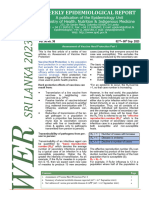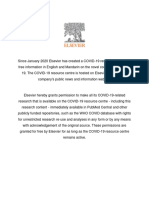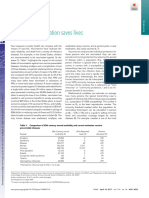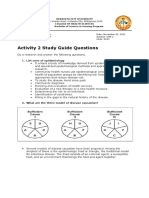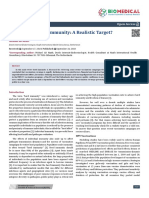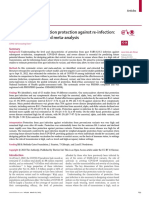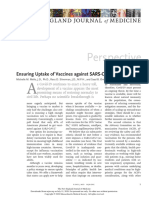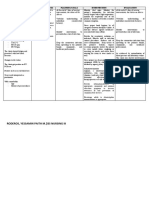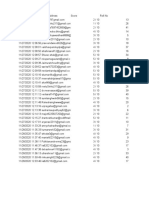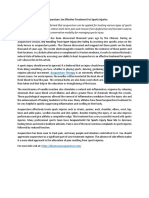Emergency Response To A Smallpox Attack: The Case For Mass Vaccination
Emergency Response To A Smallpox Attack: The Case For Mass Vaccination
Uploaded by
Novita SariCopyright:
Available Formats
Emergency Response To A Smallpox Attack: The Case For Mass Vaccination
Emergency Response To A Smallpox Attack: The Case For Mass Vaccination
Uploaded by
Novita SariOriginal Description:
Original Title
Copyright
Available Formats
Share this document
Did you find this document useful?
Is this content inappropriate?
Report this DocumentCopyright:
Available Formats
Emergency Response To A Smallpox Attack: The Case For Mass Vaccination
Emergency Response To A Smallpox Attack: The Case For Mass Vaccination
Uploaded by
Novita SariCopyright:
Available Formats
Emergency response to a smallpox attack: The case
for mass vaccination
Edward H. Kaplan*†, David L. Craft‡, and Lawrence M. Wein§
*Yale University School of Management, and Department of Epidemiology and Public Health, Yale School of Medicine, New Haven, CT 06520-8200; and
‡Operations Research Center and §Sloan School of Management, Massachusetts Institute of Technology, Cambridge, MA 02139-3407
Edited by Burton H. Singer, Princeton University, Princeton, NJ, and approved June 11, 2002 (received for review May 10, 2002)
In the event of a smallpox bioterrorist attack in a large U.S. city, the breaks. Surely strategies that contain smallpox epidemics under
interim response policy is to isolate symptomatic cases, trace and the free mixing assumption will also work under mixing patterns
vaccinate their contacts, quarantine febrile contacts, but vaccinate less favorable to the spread of disease. In this sense, our
more broadly if the outbreak cannot be contained by these mea- approach is to plan for the worst but hope for the best.
sures. We embed this traced vaccination policy in a smallpox Absent intervention, each infectious individual generates an
disease transmission model to estimate the number of cases and average of R0 ⫽ S0(0)兾r3 infections early in the epidemic (8),
deaths that would result from an attack in a large urban area. where S0(0) is the number of susceptibles immediately after an
Comparing the results to mass vaccination from the moment an attack at time t ⫽ 0, and  is the effective disease transmission
attack is recognized, we find that mass vaccination results in both rate per person per unit time. Although the transmission rate is
far fewer deaths and much faster epidemic eradication over a wide likely to decrease after the attack is detected and announced, we
range of disease and intervention policy parameters, including use a single value of R0 throughout the epidemic that represents
those believed most likely, and that mass vaccination similarly the postdetection scenario. Because the total number of deaths
SOCIAL SCIENCES
outperforms the existing policy of starting with traced vaccination is highly dependent on the number of infected persons when the
and switching to mass vaccination only if required. emergency response is initiated, an increase in the detection
delay (discussed below) or the predetection R0 has an effect
similar to increasing the initial attack size—an effect we inves-
A lthough smallpox was eradicated in 1979 by the World
Health Organization campaign (1), it remains a feared
bioterrorist threat (2). In the aftermath of the September 11
tigate later.
Newly detected symptomatic infections become ‘‘index cases,’’
terrorist attacks, the U.S. is stockpiling 286 million doses of isolated to prevent further transmission. Index cases are inter-
smallpox vaccine (3). The Centers for Disease Control and viewed to generate a list of c persons with whom they have had
Prevention (CDC) interim response plan (4) calls for targeted potentially infectious contacts in the recent past, but only a
vaccination and quarantine: symptomatic smallpox cases would fraction p of true contacts (and hence only a fraction p of
be isolated, contacts of cases vaccinated, asymptomatic contacts infectees) are named and located via contact tracing. The model
monitored but not isolated, and febrile contacts quarantined for correctly places infected contacts found in their appropriate
stage of disease while accounting for the probability that such
5 days. These guidelines also recommend a broader vaccination
persons were already traced from a prior index, and thus avoids
strategy if the initial number of cases or outbreak locations is
double counting. This crucial aspect of our analysis differs from
‘‘sufficiently large,’’ or if new cases fail to decline after two or
previous contact tracing models (9, 10) and reveals a ‘‘race to
more generations of cases have developed from those initially
trace:’’ even if a contact is identified immediately on detection
identified, or 30% of vaccine stores have been used. An expert
of the infecting index case, the time from infection of the contact
panel has also recommended a targeted vaccination strategy
to detection of the index (and tracing of the contact) can exceed
(ref. 5; http:兾兾www.bt.cdc.gov兾DocumentsApp兾Smallpox兾
the time during which the infected contact remains sensitive to
RPG兾index.asp).
the vaccine. Contact vaccination in such a circumstance is both
ineffective (the infection is not prevented) and inefficient (vac-
Model. To assess the CDC guidelines (and possible alternatives),
cine is wasted). Contact tracing can control a smallpox outbreak
we embed their key features in a disease transmission model of only if the race to trace is repeatedly won.
a smallpox attack in a large urban center. The model incorpo- Susceptible and asymptomatic infected persons located via
rates four stages of infection (1, 6), each exponentially distrib- contact tracing enter a tracing兾vaccination queue serviced by n
uted in duration with mean rj⫺1 days spent in stage j ⫽ 1, 2, 3, or vaccinators who can each process (locate and vaccinate)
4: (1) asymptomatic, noninfectious and vaccine-sensitive; persons per day on average. Only susceptibles and stage 1
(2) asymptomatic, noninfectious, and vaccine-insensitive; infected individuals can be protected via the vaccine, which is
(3) asymptomatic and infectious; and (4) symptomatic and effective with probabilities 0 and 1, respectively. Unsuccess-
isolated. In our model, the transition from stage 3 to stage 4 fully vaccinated persons return to the freely mixing population
reflects response operations in addition to disease progression. either as susceptibles or infecteds in the appropriate stage of
When an infected recognizes his or her symptoms, which may disease. On vaccination, a fraction h of individuals in stage 3 of
occur some time after the symptoms first appear, (s)he seeks infection are found to be febrile and are quarantined for ␣⫺1 days
medical help and is immediately isolated. A fraction ␦ of on average. A fraction f of vaccinations result in fatalities.
symptomatic cases die of disease, whereas the remaining fraction Mathematically, this model is described by the 17 ordinary
eventually recover (and are immune to reinfection). differential equations discussed further in the Appendix.
Disease transmission derives from free (or homogeneous) We focus on two strategies: traced vaccination (TV), described
mixing among available susceptibles and asymptomatic infec- in the last paragraph, and mass vaccination (MV), where the
tious individuals in the population. Although we recognize that
Downloaded at Indonesia: PNAS Sponsored on March 8, 2020
free mixing is not an accurate depiction of actual population
interactions, free mixing usually leads to larger epidemics than This paper was submitted directly (Track II) to the PNAS office.
nonrandom mixing would admit (7). Given the potentially Abbreviations: CDC, Centers for Disease Control; TV, traced vaccination; MV, mass vacci-
disastrous consequences of a smallpox attack, we ask whether nation.
proposed control strategies can control such ‘‘worst-case’’ out- †To whom reprint requests should be addressed. E-mail: edward.kaplan@yale.edu.
www.pnas.org兾cgi兾doi兾10.1073兾pnas.162282799 PNAS 兩 August 6, 2002 兩 vol. 99 兩 no. 16 兩 10935–10940
Table 1. Parameter values for the model
Parameter Description Value Reference
 Infection rate 10⫺7 person⫺1䡠day⫺1 See text
c Names generated per index 50 1, 9
p Fraction of infectees named by index 0.5 See text
N Population size 107 See text
r1 Disease stage 1 rate (3 days)⫺1 1
r2 Disease stage 2 rate (8 days)⫺1 1
r3 Disease stage 3 rate (3 days)⫺1 1
r4 Disease stage 4 rate (12 days)⫺1 1
n Number of vaccinators 5000 11
Service rate 50兾day (TV), 200兾day (MV) 12
h Fraction febrile in stage 3 0.9 See text
␣ Quarantine rate (5 days)⫺1 4
v0 Vaccine efficacy, stage 0 0.975 13, 14
v1 Vaccine efficacy, stage 1 0.975 13, 14
␦ Smallpox death rate 0.3 1
f Vaccination fatality rate 10⫺6 1
I10(0) Initial number infected 103 See text
entire population simultaneously enters the vaccination queue. tining febriles in Fig. 1 is to reduce the number of TV deaths
The CDC policy, which can be viewed as TV followed by a switch from 112,000 to 110,000 and the number of MV deaths from
to MV if the former is unable to contain the epidemic, will also 585 to 560.
be assessed. We also consider preattack vaccination. To allow for
detection and ramp up, TV and MV are initiated in our model
when 10% of the initial number of infected people have exhibited
symptoms.
Parameter Values. Table 1 contains the parameter values for our
base case. About half of these values are taken from classic
references (e.g., ref. 1). The infection rate  was chosen so that
R0 ⫽ 3, which is near the lower range of 3.5–6 estimated in ref.
9 (although we will vary R0 in sensitivity analyses discussed
below). We assume a large attack of 1,000 initial cases in a
population of 10 million persons in our base case but vary the
attack size between 1 and 100,000 in our sensitivity analyses
below. To estimate the number of vaccinators that could be
requisitioned in an emergency, we focus on public health nurses.
A Health Resources and Services Administration survey (11)
reports that 0.78% of the U.S. population is used in nursing,
whereas 18.3% of used nurses work in public or community
health. Applying these percentages to N ⫽ 10 million and
dividing by 3 to produce round-the-clock 8-hr shifts yields 4,758,
which we have rounded to 5,000. Vaccinators trace and vaccinate
the contacts named by index cases. In our model, it takes T and
V time units, respectively, to trace and vaccinate a named
contact. Hence, ⫺1 ⫽ T ⫹ V for TV and ⫺1 ⫽ V for MV. We
assume T ⫽ 3V, recognizing that the time required to locate
contacts is much greater than the time required for vaccination
(12), and V⫺1 ⫽ 200 per day based on the 1947 mass vaccination
of New York City (2). When we were in doubt regarding the
values of some parameter values (e.g., p and h), we erred on the
side favoring TV.
Base Case Results. Fig. 1 depicts the population dynamics of TV
and MV, both initiated on day 5, for our base case parameter
values (Table 1). TV leads to 367,000 cases and 110,000 deaths
over 350 days (Fig. 1 A), even though tracing and vaccination
resources are ample (that is, the maximum queue length in Fig.
1 A is less than the total number of available health workers)
Fig. 1. Population dynamics of a smallpox attack with the basic reproductive
Downloaded at Indonesia: PNAS Sponsored on March 8, 2020
and requires 59,000 isolation units for symptomatic cases
ratio R0 ⫽ 3. The number of infected people, regardless of disease stage, and
(but only 750 for febrile quarantine). MV takes only 10 days the number of people, whether susceptible or asymptomatically infected,
to complete, leads to 1,830 cases and 560 deaths over 115 days waiting in the vaccination queue during the aftermath of a smallpox attack.
(Fig. 1B), and requires only 690 isolation units for sympto- The (A) TV policy and the (B) MV policy are both initiated 5 days after an initial
matic cases (60 for febrile quarantine). The effect of quaran- attack of size 1,000 in a population of 107.
10936 兩 www.pnas.org兾cgi兾doi兾10.1073兾pnas.162282799 Kaplan et al.
SOCIAL SCIENCES
Fig. 2. Sensitivity analysis for uncertain model parameters. The number of deaths under TV and MV versus (A) the fraction of the population initially infected,
(B) the basic reproductive ratio R0, and (C) the number of vaccinators per capita, keeping the total population size fixed at 107. The number of deaths under TV
versus (D) the fraction of infectees named by an index.
Sensitivity Analysis and Preattack Vaccination. A sensitivity analysis 3 to 0.3 (because only 10% of the population is unvaccinated),
comparing the number of deaths incurred under TV and MV was well below the epidemic threshold. Because TV traces over 80%
performed for the three model parameters that possess the most of the population in the base case, complications due to vacci-
uncertainty (Fig. 2 A–C). TV is more sensitive than MV to the nating the immunosuppressed will be similar for TV and MV.
size of the initial attack (Fig. 2 A), and R0 (Fig. 2B). Although Also, MV eradicates the epidemic much quicker than TV,
deaths decline as the number of vaccinators increases for both making the quarantine of unvaccinated immunosuppresseds a
TV and MV (Fig. 2C, which uses a log scale), the number of viable alternative under MV.
deaths under TV is independent of the number of vaccinators Similarly, the effect of preattack vaccination (15) can be
when the latter exceeds about 2,670, which is the maximum inferred from our model. Vaccinating a fraction of the
length of the vaccination queue throughout the course of the population before an attack implies that initially a fraction
epidemic in Fig. 1 A. The TV deaths vs. R0 curve has two kinks (1 ⫺ f )0 would be immune, a fraction (1 ⫺ f )(1 ⫺ 0) would
in Fig. 2B: the curve increases at R0 ⫽ 1.36, which is the largest be susceptible and unsuccessfully vaccinated, a fraction 1 ⫺
value of R0 for which TV can contain the spread of disease, and would be susceptible and untraced, and a tiny fraction f would
further steepens at R0 ⫽ 5, when the vaccination queue becomes die of vaccine complications, where 0 is the vaccine efficacy for
congested. The TV policy is also sensitive to three other TV susceptibles (0 ⫽ 0.975 in our base case). A slightly conservative
parameters: the fraction of infectees named by an index (Fig. (i.e., over-) estimate of the postattack fatalities using either TV
2D), the ratio of tracing time to vaccination time, and the number or MV follows by reducing R0 to R0(1 ⫺ 0) in our model.
of names generated per index (not shown). Consequently, the effect of preattack vaccination, which reduces
Under either TV or MV, there may be a number of people who the gap between TV and MV, can be gleaned from Fig. 2B and
either cannot be located or who should not be vaccinated (e.g., Fig. 3 (described below). For example, if 40% of the population
people who have eczema, are pregnant, or are immunosup- undergoes preattack vaccination, R0 effectively falls from 3 to
pressed). Because prevaccination screening will likely preclude 1.83, and the number of deaths under TV and MV are 40,000 and
the vaccination of the great majority of immunosuppressed 440, respectively.
Downloaded at Indonesia: PNAS Sponsored on March 8, 2020
people, we assess this effect under MV by reducing the vaccine
efficacy. As an illustration, even if the vaccine efficacy is Comparing TV, MV, and the Interim CDC Policy. Fig. 3 shows
decreased from 0.975 to 0.9, the number of deaths increases only breakeven curves, where the total number of deaths from TV
from 560 to 700 in our base case because, although one million and MV are equal, in terms of the initial attack size and R0. For
persons remain susceptible by day 15, R0 essentially drops from the base case in which index cases name half of their contacts
Kaplan et al. PNAS 兩 August 6, 2002 兩 vol. 99 兩 no. 16 兩 10937
there exists an option to switch from TV to MV after R0 and the
initial attack size have been observed. In this setting, it would be
optimal to initiate TV on day 5 only if the decision maker were very
confident that R0 and the initial attack size are very small.
Discussion
The CDC policy is fashioned after the famed ‘‘surveillance-
containment’’ policy widely credited with the elimination of
smallpox worldwide (1, 4). Our results are not inconsistent with
the historical claims for surveillance containment, for in many of
the smallpox outbreaks the World Health Organization con-
trolled, the estimated initial number of infections was low (1, 6),
prior vaccination and recovered cases had already rendered a
high degree of herd immunity, effectively reducing R0 (8), and
contact tracing was very accurate (high p) because of the physical
layout of affected villages and the relative isolation of their
inhabitants from other areas of settlement (1). The parameters
describing many historical smallpox outbreaks would thus favor
TV over MV, as suggested by Fig. 3B. By the same token, our
breakeven curves (Fig. 3) are not inconsistent with the mass
smallpox vaccination of New York City residents in 1947 in
response to eight cases (2), because a large city has millions of
highly mobile residents and visitors that render contact tracing
difficult (low p), and because the U.S. populace may not tolerate
the length of time required for TV to eradicate a small outbreak.
In summary, compared with MV, TV slows the overall vac-
cination rate, which lengthens the time until herd immunity is
reached. As a consequence, the infection continues to spread,
potentially increasing the tracing兾vaccination burden to the
point at which significant congestion occurs. Such queuing delays
further reduce the effectiveness of vaccination, for contacts are
less likely to be in the vaccine-sensitive stage 1 of disease by the
time they are found. Worded differently, congestion makes
losing the race to trace more likely. This combination of ineffi-
cient and ineffective vaccination could also lead to quarantine
Fig. 3. Breakeven curves for the number of deaths under TV versus MV, as
overrides (because of insufficient quarantine capacity) as the
a function of the basic reproductive ratio R0 and the number of people initially
infected I (0). (A) An index names half of his or her contacts, and (B) an index
number of infections continues to spread.
successfully names all contacts. All other parameters are fixed at their base
level (Table 1).
Conclusion
We have formulated a mathematical model that, to our knowl-
edge, is the first to capture two crucial and interrelated features
(Fig. 3A), even if only several people are exposed in the initial for comparing TV and MV: a detailed analysis of the race to
attack, MV generates less deaths than TV if R0 ⬎ 1.3, which is trace and the queuing caused by limited tracing and vaccination
well below most estimates for smallpox R0 (9). Similarly, with the resources. Our results show that over a wide range of scenarios,
optimistic assumption that index cases successfully name all MV leads to many fewer deaths than TV. Moreover, the cost in
contacts (Fig. 3B), MV results in fewer deaths than TV if R0 ⬎ 2. both deaths and time of delaying the switch to MV—as suggested
Highly asymmetric consequences lurk behind Fig. 3: in the by the interim CDC policy—is very high, particularly in light of
region where TV is favored, the number of deaths under each the public clamoring for vaccination and the mass panic that
strategy is quite small, whereas in the region where MV is would likely ensue in the event of an attack. For these reasons,
favored, TV may generate many thousands of deaths over a given our current states of knowledge and response capabilities
number of months. Moreover, if the MV vs. TV decision ever has [e.g., there is no widely accepted screening test for smallpox (5)],
to be made, the value of R0 will not be known more precisely than we believe that unless preattack vaccination is used to signifi-
at present, and an accurate estimate of the initial attack size may cantly increase herd immunity in the population, serious con-
not be available (ref. 16; http:兾兾www.hopkins-biodefense.org兾 sideration should be given to replacing the existing CDC policy
lessons.html). Hence, a decision maker concerned with mini- by MV in the event of a smallpox attack in a large urban center.
mizing the number of deaths in the face of this uncertainty
should choose TV only if (s)he is quite certain that R0 and the Appendix
initial attack size fall in the TV-favorable region of Fig. 3. Throughout, the subscript j denotes stage of infection, whereas
We model the CDC guidelines by switching from TV to MV 28 the superscript ᐉ denotes whether a person has yet to be traced
days (i.e., two generations, where ¥3j ⫽ 1 rj⫺1 ⫽ 14 days) after the start (ᐉ ⫽ 0) or has already been traced and vaccinated (ᐉ ⫽ 1). All
of TV (e.g., on day 33 in the base case). Doing so leads to 4,680 parameters used are defined in Table 1. The state variables are:
deaths and 15,570 cases over 165 days in the base case, whereas the Sᐉ ⫽ number of type ᐉ susceptibles; Ijᐉ ⫽ number of type ᐉ
epidemic peaks at 38 days with 11,400 persons infected. The cost of infected persons in disease stage j (j ⫽ 1, 2, 3, 4); Qj ⫽ number
Downloaded at Indonesia: PNAS Sponsored on March 8, 2020
waiting to switch from TV to MV is very high—4,120 incremental in tracing兾vaccination queue at disease stage j (j ⫽ 0 means
deaths in our base case compared with responding with MV from susceptibles); H ⫽ number in febrile quarantine; Z ⫽ number
the start. Consider a strategy that has two decision points: on day immune (from vaccination) or recovered from smallpox; D ⫽
5, the TV vs. MV decision is made with imprecise information about number dead. We also denote the total number of freely mixing
R0 and the initial attack size, and (as in the CDC plan) on day 33 infectious individuals as I3 ⫽ I03 ⫹ Q3 ⫹ I13, and the total number
10938 兩 www.pnas.org兾cgi兾doi兾10.1073兾pnas.162282799 Kaplan et al.
3
of persons in the tracing兾vaccination queues as Q ⫽ ¥j⫽0 Q j. dH
Finally, define to be the time interval between the smallpox ⫽ 共1 ⫺ f兲h Q 3 min共1, n兾Q兲 ⫺ r3H ⫺ ␣H, [8]
dt
attack and the initiation of intervention. Whereas in the text the
attack occurs at time t ⫽ 0 and the response begins at time t ⫽
as quarantined individuals do not contribute to disease trans-
(5 days in our base case), to ease the presentation in the
equations below, we let the attack occur at time t ⫽ ⫺ and mission but continue to progress to smallpox.
the response begin at time t ⫽ 0. These assumptions lead to the
Traced but Unsuccessfully Vaccinated States. All unsuccessfully
following ordinary differential equations.
vaccinated individuals (except those in quarantine or vaccine
Untraced States. Disease transmission occurs in accord with the fatalities) freely mix in the population, contributing to disease
usual mass action law, whereas disease progression occurs with transmission, while disease progression occurs in the usual way.
stage-dependent constant hazard rates. Previously untraced
contacts who are named by their true index of infection and dS 1
⫽ 共1 ⫺ f兲共1 ⫺ v 0 兲 Q 0 min共1, n兾Q兲 ⫺ S1I3 [9]
found are traced by their appropriate stage of disease accounting dt
for their (random) time of infection by the index {[pj(t)] terms
in Eqs. 2 and 3}. In contrast, those previously untraced contacts dI 11
who are susceptible, or infected but named by someone other ⫽  S 1 I 3 ⫹ 共1 ⫺ f兲共1 ⫺ v 1 兲 Q 1 min共1, n兾Q兲 ⫺ r1I11
dt
than their true index of infection, trace proportionately over all [10]
untraced individuals {[c ⫺ pR0(t)] terms in Eqs. 1–3; both
functions R0(t) and j(t) will be explained further shortly}. Note dI 12
that no tracing occurs before time t ⫽ 0. ⫽ r 1 I 11 ⫹ 共1 ⫺ f兲 Q 2 min共1, n兾Q兲 ⫺ r2I12 [11]
dt
0 0
dS S
⫽ ⫺I3S0 ⫺ 关c ⫺ pR0共t兲兴 r3I3 [1]
SOCIAL SCIENCES
dt N dI 13
⫽ r 2 I 12 ⫹ 共1 ⫺ f兲共1 ⫺ h兲 Q 3 min共1, n兾Q兲 ⫹ ␣H ⫺ r3I13
再 冎
dt
dI 01 I 01 [12]
⫽  I 3 S 0 ⫺ 关c ⫺ pR 0 共t兲兴 ⫹ p 1 共t兲 r 3 I 3 ⫺ r 1 I 01
dt N
[2] dI 14
⫽ r 3 共I 13 ⫹ Q 3 ⫹ H兲 ⫺ r 4 I 14 . [13]
再 冎
dI j0 I j0 dt
⫽ r j ⫺ 1 I 0j ⫺ 1 ⫺ 关c ⫺ pR 0 共t兲兴 ⫹ p j 共t兲 r 3 I 3 ⫺ r j I j0
dt N Immune兾Recovered and Death States. Successful vaccinations oc-
for j ⫽ 2, 3 [3] cur with probability 0 and 1 for susceptibles and those in stage
1 disease, respectively, whereas the fraction 1 ⫺ ␦ of those who
dI 04
⫽ r 3 I 03 ⫺ r 4 I 04 . [4] progress to symptomatic smallpox eventually recover (on aver-
dt age r⫺1 days after development of symptoms) and remain
4
immune. However, the fraction ␦ of those who develop smallpox
Queueing States. Until t ⫽ 0, there is no tracing and hence no die of the disease, whereas the fraction f of all those vaccinated
queuing. Once t ⬎ 0, note that because only n tracers兾vaccinators die of vaccine-related complications.
are available, the total flow out of the queuing states can never
exceed n per day. If the system becomes congested (more than
dZ
n persons are in the queue), then those in queue in disease stage ⫽ 共1 ⫺ f兲共v 0 Q 0 ⫹ v 1 Q 1 兲 min共1, n兾Q兲 ⫹ 共1 ⫺ ␦兲r4共I04 ⫹ I14兲
j receive service at rate nQj兾Q, that is, the service provided is dt
proportional to the relative numbers in queue. This explains the [14]
min(1, n兾Q) in Eqs. 5–7. Disease transmission and progression
continue unabated among those in the queue. dD
⫽ f Q min共1, n兾Q兲 ⫹ ␦r4共I04 ⫹ I14兲. [15]
dt
dQ 0 S0
⫽ 关c ⫺ pR 0 共t兲兴 r I ⫺  I 3 Q 0 ⫺ Q 0 min共1, n兾Q兲
dt N 3 3 The Functions R0(t) and j (t). When a newly symptomatic smallpox
[5] case is discovered at time t, she will have infected on average
再 冎
R0(t) persons over her duration of infectiousness, where
dQ 1 I 01
冕
⫽  I 3 Q 0 ⫹ 关c ⫺ pR 0 共t兲兴 ⫹ p 1 共t兲 r 3 I 3
dt N t⫹
R 0 共t兲 ⫽ e⫺r3x关S0共t ⫺ x兲 ⫹ Q0共t ⫺ x兲 ⫹ S1共t ⫺ x兲兴 dx
⫺ Q 1 min共1, n兾Q兲 ⫺ r1Q1 [6]
0
dQ j
dt
再 I j0
⫽ r j ⫺ 1 Q j ⫺ 1 ⫹ 关c ⫺ pR 0 共t兲兴 ⫹ p j 共t兲 r 3 I 3
N
冎 ⬇
关S0共t兲 ⫹ Q0共t兲 ⫹ S1共t兲兴
r3
, [16]
⫺ Q j min共1, n兾Q兲 ⫺ rjQj for j ⫽ 2, 3 [7]
with the quasistationary approximation (i.e., the epidemic is
Stage 3 Quarantine (Holding) State. Under CDC policy, in addition viewed as fixed on a short time scale) following from the fact that
to symptomatic cases, only febrile individuals are subject to persons are infectious for only 3 days on average, which is very
short relative to the duration of the overall epidemic. Note that
Downloaded at Indonesia: PNAS Sponsored on March 8, 2020
quarantine. We assume that a fraction h of infectious (stage 3)
individuals are identified as febrile and are remanded to quar- R0(0) ⫽ S0(0)兾r3 ⫽ R0, as defined in the text. Of the R0(t)
antine of mean duration ␣⫺1 days at the time they are processed persons previously infected by an index detected at time t, some
in the vaccination queue (except for vaccine fatalities), which will already have been named at random by other index cases
leads to even though no transmission occurred. The rate with which
Kaplan et al. PNAS 兩 August 6, 2002 兩 vol. 99 兩 no. 16 兩 10939
anyone in the population is randomly traced at time u ⱖ 0 is given where qj(t) is (approximately) the conditional probability that a
by contact of an index detected at time t is in stage j of disease given
that the contact has not been traced by time t, and equals
关c ⫺ pR 0 共u兲兴r 3 I 3 共u兲
共u兲 ⫽ [17]
写
N j⫺1
rk r 3 ⫹ 共t兲
q j 共t兲 ⫽ ⫻ . [19]
[(u) ⫽ 0 otherwise]. Therefore, the expected number of un- r k ⫹ r 3 ⫹ 共t兲 r j ⫹ r 3 ⫹ 共t兲
k⫽1
traced contacts previously infected by an index detected at time
t who are in disease stage j when the index is detected is equal to
The justification for the approximation in Eqs. 18 and 19 is the
冕 t⫹ same quasistationary argument used in Eq. 16.
t
j 共t兲 ⫽ e⫺ r 3x  S 0 共t ⫺ x兲e⫺兰 t ⫺ x 共u兲du
0
We thank Ellis McKenzie of the Fogarty International Center, National
Institutes of Health, for initiating this project. This work was supported
⫻ Pr兵Contact in stage j at t 兩 infected at t ⫺ x其 dx by the Societal Institute for the Mathematical Sciences, via Grant
DA-09351 from the National Institute on Drug Abuse (E.H.K.) and a
S0共t兲 grant from the Singapore–Massachusetts Institute of Technology Alli-
⬇ qj共t兲 , [18]
r3 ⫹ 共t兲 ance (L.M.W.).
1. Fenner, F., Henderson, D. A., Arita, I., Jezek Z. Ladnyi, I. D. (1988) Smallpox 10. Müller, J., Kretzschmar, M. & Dietz, K. (2000) Math. Biosci. 164,
and Its Eradication (World Health Organization, Geneva). 39 – 64.
2. Henderson, D. A. (1999) Science 283, 1279–1282. 11. Division of Nursing, Bureau of Health Professions, Health Resources and
3. Check, E. (2001) Nature (London) 414, 677. Services Administration (2001) The Registered Nurse Population (Health Re-
4. Centers for Disease Control (2001) CDC Interim Smallpox Response Plan and sources and Services Administration, Washington, DC).
Guidelines (Centers for Disease Control, Atlanta, GA), Draft 2.0. 12. Macke, B. A., Hennessy, M., McFarlane, M. M. & Bliss, M. J. (1998) Sex.
5. Henderson, D. A. (1999) J. Am. Med. Assoc. 281, 2127–2137. Transm. Dis. 25, 561–568.
6. Meltzer, M. I., Damon, I., LeDuc, J. W. & Millar, J. D. (2001) Emerg. Infect. 13. Mack, T. M. (1972) J. Infect. Dis. 125, 161–169.
Dis. 7, 959–969. 14. Mack, T. M., Thomas, D. B. & Khan, M. M. (1972) Am. J. Epidemiol. 95,
7. Kaplan, E. H. (1991) Math. Biosci. 105, 97–109. 157–168.
8. Anderson, R. M. & May, R. M. (1991) Infectious Diseases of Humans (Oxford 15. Bicknell, W. J. (2002) N. Engl. J. Med. 346, 1323–1325.
Univ. Press, Oxford). 16. O’Toole, T. & Inglesby, T. (2001) Shining Light on Dark Winter (Johns Hopkins
9. Gani, R. & Leach, S. (2001) Nature (London) 414, 748–751. Center for Civilian Biodefense Strategies, Baltimore).
Downloaded at Indonesia: PNAS Sponsored on March 8, 2020
10940 兩 www.pnas.org兾cgi兾doi兾10.1073兾pnas.162282799 Kaplan et al.
You might also like
- One Health 2014Document331 pagesOne Health 2014María Paula CuellarNo ratings yet
- PLOTKINDocument6 pagesPLOTKINElPaisUyNo ratings yet
- Blaker NUR 427 Contagion AnalysisDocument5 pagesBlaker NUR 427 Contagion AnalysisJenni CavanaughNo ratings yet
- Community Medicine OspeDocument4 pagesCommunity Medicine OspeHammad Shafi100% (1)
- Pediatric Cardiac Patients: History TakingDocument31 pagesPediatric Cardiac Patients: History TakingnovylatifahNo ratings yet
- Epid 4Document4 pagesEpid 4lakshanNo ratings yet
- 1.1 REFERENCE DOCUMENT Pandemic Crisis Management Team (L) 08312009Document13 pages1.1 REFERENCE DOCUMENT Pandemic Crisis Management Team (L) 08312009shifo41No ratings yet
- Journal Pone 0261330Document51 pagesJournal Pone 0261330Cristian Fernando Sanabria BautistaNo ratings yet
- Circadian Influences of Diet On The Microbiome and Immunity - Parte 2Document9 pagesCircadian Influences of Diet On The Microbiome and Immunity - Parte 2Mércia FiuzaNo ratings yet
- Herd Immunity Pada Covid 19 - Kelompok 1Document14 pagesHerd Immunity Pada Covid 19 - Kelompok 1NaifahLuthfiyahPutriNo ratings yet
- Pandemic Planning: Non-Pharmaceutical InterventionsDocument5 pagesPandemic Planning: Non-Pharmaceutical InterventionsjamesgarrowNo ratings yet
- NM 1273Document7 pagesNM 1273Ngọc Minh Anh NguyễnNo ratings yet
- Transition To Endemicity: Understanding COVID-19Document5 pagesTransition To Endemicity: Understanding COVID-19freeda mervinNo ratings yet
- Clin Infect Dis.-2011 - 911-6Document6 pagesClin Infect Dis.-2011 - 911-6ko nayNo ratings yet
- Medical Surgical Nursing Module 2Document6 pagesMedical Surgical Nursing Module 2JAY TOM BOLIVARNo ratings yet
- 10 11648 J Engmath 20160101 14Document10 pages10 11648 J Engmath 20160101 14nessa_hidayatulNo ratings yet
- Laboratory Diagnosis of Virus DiseasesDocument21 pagesLaboratory Diagnosis of Virus DiseasesVictor CostaNo ratings yet
- Epid 2Document4 pagesEpid 2lakshanNo ratings yet
- Herd Immunity: Understanding COVID-19: PrimerDocument5 pagesHerd Immunity: Understanding COVID-19: PrimerLeandro RodríguezNo ratings yet
- The Convalescent Sera Option For Containing COVID-19: Arturo Casadevall, Liise-Anne PirofskiDocument5 pagesThe Convalescent Sera Option For Containing COVID-19: Arturo Casadevall, Liise-Anne PirofskiKaren LizethNo ratings yet
- Active Surveillance Guide Japan FinalDocument24 pagesActive Surveillance Guide Japan FinalJulian Sanchez ViamonteNo ratings yet
- Analysis and Prediction of COVID-19 Pandemic in Pakistan Using Time-Dependent SIR ModelDocument11 pagesAnalysis and Prediction of COVID-19 Pandemic in Pakistan Using Time-Dependent SIR ModelafaqNo ratings yet
- Perspective: New England Journal MedicineDocument3 pagesPerspective: New England Journal MedicineRudy SanabriaNo ratings yet
- Orenstein Ahmed 2017 Simply Put Vaccination Saves LivesDocument3 pagesOrenstein Ahmed 2017 Simply Put Vaccination Saves Livesthedevilsoul981No ratings yet
- Systemic Risk of Pandemic Via Novel Path PDFDocument2 pagesSystemic Risk of Pandemic Via Novel Path PDFBooster HidroNo ratings yet
- Activity 2 Study Guide Questions WEEK 6 CHN 2 FERRER JOHN DENVER A.Document7 pagesActivity 2 Study Guide Questions WEEK 6 CHN 2 FERRER JOHN DENVER A.Novelyn PuaNo ratings yet
- The Theory of Measles Elimination: Implications For The Design of Elimination StrategiesDocument9 pagesThe Theory of Measles Elimination: Implications For The Design of Elimination StrategiesAgus Salim ArsyadNo ratings yet
- COVID-19: Mechanisms of Vaccination and Immunity: Daniel E. Speiser and Martin F. BachmannDocument19 pagesCOVID-19: Mechanisms of Vaccination and Immunity: Daniel E. Speiser and Martin F. BachmannAleksandar DimkovskiNo ratings yet
- Disease Mitigation Measures in The Control of Pandemic InfluenzaDocument10 pagesDisease Mitigation Measures in The Control of Pandemic InfluenzaZerohedge100% (1)
- Johnston 2007Document9 pagesJohnston 2007MedranoReyesLuisinNo ratings yet
- Sepsis in 2018: A Review: Learning ObjectivesDocument8 pagesSepsis in 2018: A Review: Learning ObjectivesViky DamayNo ratings yet
- CH#01Document4 pagesCH#01Emran khanNo ratings yet
- A Measles Outbreak in An Underimmunized Amish Community in OhioDocument12 pagesA Measles Outbreak in An Underimmunized Amish Community in Ohiomuhammad maadaNo ratings yet
- Herd Immunity: A Realistic Target?: Mini Review Open AccessDocument5 pagesHerd Immunity: A Realistic Target?: Mini Review Open AccessAshwinee KadelNo ratings yet
- Measles Outbreak NejmoaDocument12 pagesMeasles Outbreak NejmoaVlad ManoleNo ratings yet
- Past SARS-CoV-2 Infection Protection Against Re-InfectionDocument10 pagesPast SARS-CoV-2 Infection Protection Against Re-InfectionRoel PlmrsNo ratings yet
- 2018 Article 296 PDFDocument10 pages2018 Article 296 PDFDiego RomaNo ratings yet
- Gomesetal JTBDocument11 pagesGomesetal JTBEbrar YALÇINKAYANo ratings yet
- Investigation of OutbreakDocument92 pagesInvestigation of OutbreakEvan PermanaNo ratings yet
- Principles of Infectious DiseasesDocument19 pagesPrinciples of Infectious DiseasesThạnh NgôNo ratings yet
- Austin Journal of Infectious DiseasesDocument4 pagesAustin Journal of Infectious DiseasesAustin Publishing GroupNo ratings yet
- The Convalescent Sera Option For Containing COVID-19: Arturo Casadevall, Liise-Anne PirofskiDocument5 pagesThe Convalescent Sera Option For Containing COVID-19: Arturo Casadevall, Liise-Anne PirofskiJoseLuisNo ratings yet
- GetahunLTBINEJM2015 PDFDocument9 pagesGetahunLTBINEJM2015 PDFSharah Stephanie IINo ratings yet
- Ionindis 2020Document5 pagesIonindis 2020Chingura LuffyNo ratings yet
- HHS Public Access: Multidrug Resistant Bacteria in The Community: Trends and Lessons LearnedDocument17 pagesHHS Public Access: Multidrug Resistant Bacteria in The Community: Trends and Lessons LearnedGgb111No ratings yet
- Modelling of COVID-19 Vaccination Strategies and Herd ImmunityDocument8 pagesModelling of COVID-19 Vaccination Strategies and Herd ImmunitydewiNo ratings yet
- Articulo MalariaDocument19 pagesArticulo MalariaAndres Felipe DuqueNo ratings yet
- Msphere.00927-20 Obat Mongkey PoxDocument15 pagesMsphere.00927-20 Obat Mongkey PoxAndi ToniNo ratings yet
- 141 Research Studies Affirm Naturally Acquired Immunity To Covid-19 (Brownstone Institute 2021)Document40 pages141 Research Studies Affirm Naturally Acquired Immunity To Covid-19 (Brownstone Institute 2021)gd_hbarNo ratings yet
- 46 FullDocument10 pages46 FullFaiz SheeNo ratings yet
- Summary For ModellingDocument4 pagesSummary For ModellingAnonymous UpWci5No ratings yet
- Haydon Et Al - 2002Document6 pagesHaydon Et Al - 2002SoniaMaricelNo ratings yet
- Sep 15 Final Cpsa LetterDocument19 pagesSep 15 Final Cpsa LetterFatima Berriah CamposNo ratings yet
- Naming PDFDocument9 pagesNaming PDFBireswar BhattacharyaNo ratings yet
- Vaccination Strategies Against COVID 19 and The Diffusion of Anti Vaccination ViewsDocument13 pagesVaccination Strategies Against COVID 19 and The Diffusion of Anti Vaccination ViewsShaila PrabhuNo ratings yet
- Seminar: William J MossDocument13 pagesSeminar: William J MossKenef Cheung100% (1)
- Forced Vaccination Nejmp2020926Document3 pagesForced Vaccination Nejmp2020926Lika MaharNo ratings yet
- White Paper - Effective-Covid19-Control-through-carrier-tracking-and-non-pharmaceutical-interventions-v2.0-2Document45 pagesWhite Paper - Effective-Covid19-Control-through-carrier-tracking-and-non-pharmaceutical-interventions-v2.0-2Daniel SloanNo ratings yet
- Practical Applications of Immunology Written ReportDocument9 pagesPractical Applications of Immunology Written ReportVincent Drystan AdronNo ratings yet
- Mikaeloff 2008Document9 pagesMikaeloff 2008gaby109603No ratings yet
- 5 Disease Transmission and Outbreak Investigation - 1Document10 pages5 Disease Transmission and Outbreak Investigation - 1RoniAnasoka100% (1)
- Lesson 9-10 CPHDocument26 pagesLesson 9-10 CPHGeraldine SalonNo ratings yet
- Vaccination of Healthcare Workers A ReviewDocument17 pagesVaccination of Healthcare Workers A Reviewy2h996tnp8No ratings yet
- Infectious Diseases in Solid-Organ Transplant Recipients: A practical approachFrom EverandInfectious Diseases in Solid-Organ Transplant Recipients: A practical approachOriol ManuelNo ratings yet
- Powerpoint TaeniasisDocument23 pagesPowerpoint TaeniasisAyshaShariff0% (1)
- Amoeb Iasis: By: Sytrose Morales TabacoDocument13 pagesAmoeb Iasis: By: Sytrose Morales TabacoSytrose MoralesNo ratings yet
- Community Health Nursing II NotesDocument11 pagesCommunity Health Nursing II NotesMarjorie UmipigNo ratings yet
- Eferesis 2008Document17 pagesEferesis 2008xander trujilloNo ratings yet
- Hiv & Aids EssayDocument4 pagesHiv & Aids Essayapi-247525636No ratings yet
- Diseases of External Ear & Otitis MediaDocument36 pagesDiseases of External Ear & Otitis MediaNguyễn ThànhNo ratings yet
- RTPCRDocument3 pagesRTPCRMohammed AnwarNo ratings yet
- Risk For Infection Related To Failure To Avoid Pathogen Secondary To Exposure To COVID-19Document2 pagesRisk For Infection Related To Failure To Avoid Pathogen Secondary To Exposure To COVID-19Yessamin Paith Roderos100% (1)
- Sti GonorrheaDocument6 pagesSti GonorrheaSulaiman NajirulNo ratings yet
- New Laboratory TestsDocument35 pagesNew Laboratory TestsCar SadNo ratings yet
- The Principles For Care of HcapDocument44 pagesThe Principles For Care of HcapAfifah KartikasariNo ratings yet
- Autoimmune EncephalitisDocument10 pagesAutoimmune EncephalitisMagda CabralesNo ratings yet
- Association Between Nutritional Status and Severity of Pneumonia Among Children Under Five Years Attending Wangaya District HospitalDocument7 pagesAssociation Between Nutritional Status and Severity of Pneumonia Among Children Under Five Years Attending Wangaya District HospitalchairulNo ratings yet
- MeaslesDocument4 pagesMeaslesSweetyfe GabatanNo ratings yet
- Raw 2 LawsDocument17 pagesRaw 2 LawsRed HaleNo ratings yet
- English Hiv LeafletDocument2 pagesEnglish Hiv LeafletVega HapsariNo ratings yet
- Nursing Care Plan For Meconium Aspiration SyndromeDocument1 pageNursing Care Plan For Meconium Aspiration SyndromeMaryGraceVelascoFuentes100% (1)
- On Mantel HaenszelDocument3 pagesOn Mantel HaenszelAnonymous rfn4FLKD8No ratings yet
- Epi Unit 2-1Document21 pagesEpi Unit 2-1Priya bhattiNo ratings yet
- Health 8 Q2 Mod 9 Get Immunized v2Document23 pagesHealth 8 Q2 Mod 9 Get Immunized v2Ligaya BacuelNo ratings yet
- HealthDocument17 pagesHealthRosevick BadocoNo ratings yet
- Explain Why You Chose The Data Set(s) You Did, Who The Target Audience Is and The Purpose For Which They Might Use The DataDocument4 pagesExplain Why You Chose The Data Set(s) You Did, Who The Target Audience Is and The Purpose For Which They Might Use The DatalaronNo ratings yet
- Agesta CodesDocument15 pagesAgesta CodesLuigi Voltolini100% (1)
- Art Integrated Test Class 4 Anita Pandey (Responses)Document4 pagesArt Integrated Test Class 4 Anita Pandey (Responses)Anita PandeyNo ratings yet
- Control de Lectura 1Document4 pagesControl de Lectura 1Anonymous Pg5x01P3No ratings yet
- Acupuncture An Effective Treatment For Sports InjuriesDocument1 pageAcupuncture An Effective Treatment For Sports InjuriesandreasNo ratings yet





